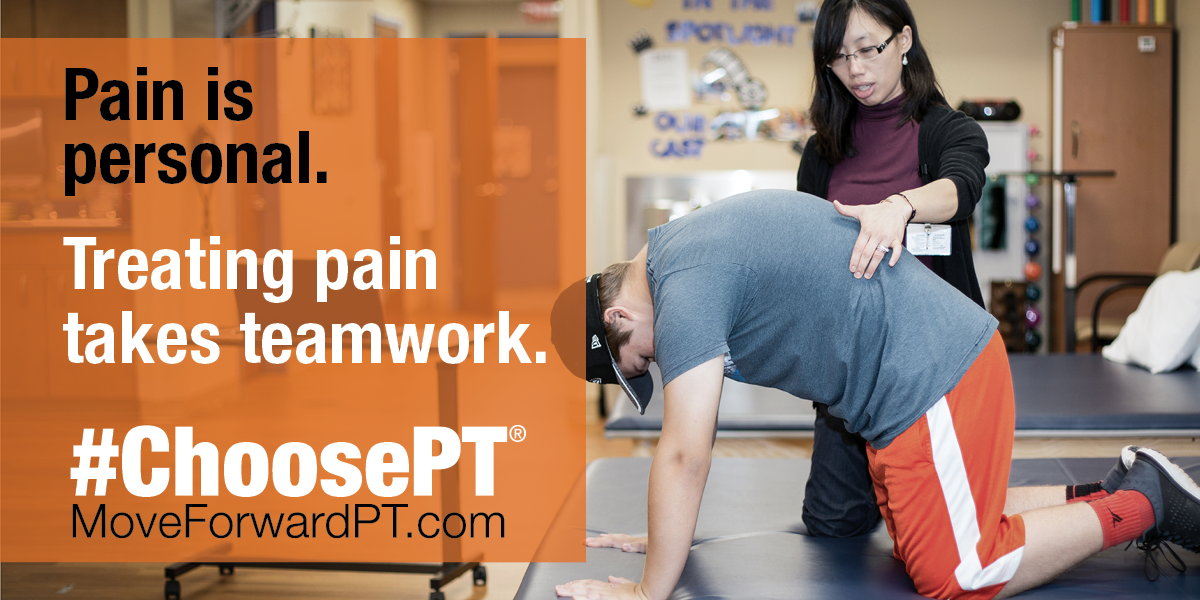October was National Physical Therapy Month. For the last several years, to mark this occasion the American Physical Therapy Association (APTA) has been working to raise awareness about the value of utilizing physical therapy as an alternative to opiod pain medication. Some potentially positive news has recently been reported regarding the ongoing opiod crisis, as the Centers for Disease Control and Prevention (CDC) has recorded a plateau in 2018 in the number of deaths occurring annually from opiod overdose – rather than ongoing spikes in death rates as were observed in 2016 and 2017. Unfortunately, this plateau still involves outrageous numbers – with over 69,000 overdose deaths in the US this year. A common physical problem that is often addressed with opiod prescriptions is that of low back pain. The following is an article recently posted by the APTA about this subject:
If you’re living with low back pain (LBP), you’re not alone. The condition is the leading cause of disability in the U.S. Studies show that 80 percent of American adults will experience LBP at some point in their lives! Acute (recent onset) low back pain can be a major, if temporary, inconvenience. And if LBP turns from short-term to chronic (lasting three months or longer), it can significantly impact your ongoing overall quality of life.
Modern society craves quick-fix solutions to even complex problems, but this mindset can be particularly counterproductive when it comes to LBP. Studies show that LBP is often over-treated, particularly when it comes to the use of opioid medications, imaging scans (such as MRIs and X-rays), and surgery. Guidelines recommend first trying exercise and other conservative approaches instead.
“When it comes to low back pain, the best advice is to move,” said APTA spokesperson Colleen Louw, PT, MEd. “Most low back pain will resolve without invasive measures and responds positively to increased movement and regular exercise.”
As America seeks solutions to its ongoing opioid epidemic, patients and prescribers should be especially cautious about treating LBP with opioids. Opioids come with a list of serious potential side effects, and every day more than 1,000 people are treated in emergency departments for opioid misuse. Meanwhile, long-term use of opioids might not be particularly helpful for LBP, which is why the Centers for Disease Control and Prevention (CDC) released guidelines urging the use of safer alternatives, including physical therapy, for most non-cancer-related chronic pain conditions.
“Given the substantial evidence gaps on opioids, uncertain benefits of long-term use and potential for serious harm, patient education and discussion before starting opioid therapy are critical so that patient preferences and values can be understood and used to inform clinical decisions,” the CDC states.
Physical therapists can play a valuable role in the patient education process about low back pain, including setting realistic expectations for recovery with or without opioids.
Physical therapists are movement experts who optimize quality of life through prescribed exercise, hands-on care and patient education.
A physical therapist assessing a patient with low back pain will perform a thorough evaluation that includes: • A review of your health history. • Questions about your specific symptoms. • A detailed examination that includes assessing the quality and quantity of your movements, and any movement behaviors that might put you at risk for delayed recovery. • Tests to identify signs or symptoms that could indicate a serious health problem, such as broken bones or cancer. • Assessment of how you use your body at work, home, during sports and at leisure. An active treatment plan from a physical therapist can help you improve your mobility while managing your pain, whereas opioids only mask the sensation of pain.
Here are four reasons to choose physical therapy for your back pain:
- Physical therapy is a safe and effective alternative to opioids. While doctor-prescribed opioids are appropriate in some cases, choosing a safer alternative, like physical therapy, eliminates the risk of misuse and avoids the potential negative side effects. Your physical therapist will set realistic expectations for recovery, with or without opioids.
- Physical therapists help you to help yourself. Physical therapists empower you to be an active participant in your own treatment.
- Physical therapy is cost effective. A recent study shows that patients with LBP who consult physical therapists early in their treatment processes incur lower out-of-pocket medical costs per back pain episode, with less probability of accruing expenses associated with opioid prescriptions, advanced imaging services or emergency room visits.
- Physical therapy is accessible. Average wait times to see a physical therapist for evaluation of back pain typically range from 1-5 business days. Many physical therapy clinics take appointments before and after typical work hours and/or during the lunch hour for patient convenience. Average wait times for appointments with other medical specialists are often measured in weeks, or even months, and it is not unusual for specialist appointments to be limited to standard business hours.
Low back pain is an issue that can be effectively treated – particularly when the condition is addressed early. We invite you to contact your physical therapist soon for assistance in managing and resolving any issues that are nagging you and/or limiting the activities that you enjoy.

